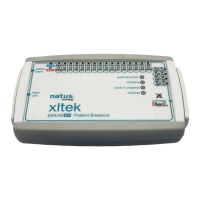Xltek
®
EMU40EX™ User and Service Manual
56
Measurements
If the accuracy of any measurement does not seem reasonable, check the patient’s vital signs by
alternative means. Then, check the pulse oximeter for proper functioning.
Causes of Inaccurate Measurements
Incorrect sensor application or use.
Significant levels of dysfunctional hemoglobins (e.g. carboxyhemoglobin or methemoglobin).
Intravascular dyes such as indocyanine green or methylene blue.
Exposure to excessive illumination, such as surgical lamps (especially ones with a xenon light
source), bilirubin lamps, fluorescent lights, infrared heating lamps, or direct sunlight. Exposure to
excessive illumination can be corrected by covering the sensor with a dark or opaque material.
Excessive patient movement.
Venous pulsations.
Placement of a sensor on an extremity with a blood pressure cuff, arterial catheter, or
intravascular line.
Causes of Loss of Pulse Signal
Sensor is too tight.
Excessive illumination from light sources such as a surgical lamp, a bilirubin lamp, or sunlight.
Blood pressure cuff is inflated on the same extremity as the one with a SpO
2
sensor attached.
Patient has hypotension, severe vasoconstriction, severe anemia, or hypothermia.
Arterial occlusion is proximal to the sensor.
Patient is in cardiac arrest or is in shock.

